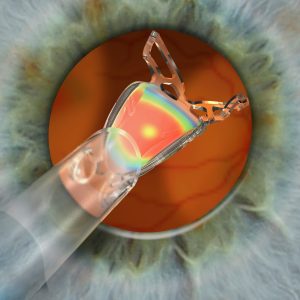The presbyopia is an age-related physiological condition of the visual apparatus characterised by the loss of the ability to focus on near objects. Being a physiological phenomenon linked to ageingIt is the most common refractive disorder among all those over 40 years of age, regardless of gender.
The inevitability of this phenomenon should make presbyopia correction one of the largest markets in eyecare, and indeed the focus on this area by manufacturers and the strides made by research in this branch, have made it available to patients increasingly safe and well-tolerated optical products, intraocular lenses and surgical techniques.
The most common solution to presbyopia is the use of the reading glassesbut the non-acceptance of this visual aid, combined with the clear functional and aesthetic advantages of living without spectacles, has prompted a large fraction of presbyopes to search and choose between alternatives the market offers today. Alternatives also valued by those patients who undergo cataract surgery and wish, after the operation, not to be forced to wear glasses.
For both utilities, the natural lens replacement with multifocal intraocular lenses (IOLs) represents the ideal choice for the realisation of a spectacle-free life. The market for multifocal IOLs, whether for refractive purposes (refractive lent exchange - RLE) or following cataract surgery with premium IOLs, is therefore expanding considerably, and the emergence of a so-called 'Generation Xchange', consisting of professionals in their 40s whose modern lifestyle makes it an attractive choice to undergo an IOL implant rather than adapt to wearing spectacles, is also contributing to this.
Advances made in the optical design of IOLs, together with improvements in diagnostics in biometric and aberrometric examination, the introduction of Femto Laser Assisted Cataract Surgery (FLACS) and, of course, patient refractive outcomes have greatly favoured the use of these intraocular lenseswhich, however, is currently not as widespread as it could be. One of the causes is the inconveniences the patient may experience following the implantation of IOLs of 'traditional' design, with diffractive optics or including apodization, which may lead to some and photic problems (glare, halos, etc.).
Can the IOL implant with a more advanced optical design reduce these drawbacks?
Thirteen distinguished cataract surgeons, led by Prof. Vittorio Picardo, gathered for the first 'users' meeting of the IOL MINI WELL® of SIFI, held in Milan last May to discuss. During the meeting, the clinical profile of the ideal patient in terms of both physical and psychological parameters in order to ensure maximum post-implantation satisfaction. The Experts also discussed the pre-operative examinations essential for the choice of the most correct and appropriate IOL for each patient, emphasising the advantages of modern biometric and aberrometric examinations. The meeting also illustrated correlation studies between pre-operative parameters and post-operative results, and comparative studies between the EDOF IOL MINI WELL® and other similar lenses available on the market.
The clinical results of the IOL MINI WELL show excellent quality of vision, high patient satisfaction... and surgeon satisfaction!
Learn more about the MINI WELL intraocular lens® We invite you to read data, opinions and experiences of the meeting participants collected in a supplement available for download at this address:
https://theophthalmologist.com/issues/0917/mini-wellr-a-better-vision/
Panel of experts
Giovanni Alessio, Department of Ophthalmology, University of Bari, Italy.
Gerd U. Auffarth, Department of Ophthalmology, University of Heidelberg, Germany.
Andrea Bedei, 'San Rossore' Medical Centre, Pisa, Italy.
Roberto Bellucci, Department of Ophthalmology, Hospital and University of Verona, Verona, Italy.
Claudio Carbonara, Primavista Eye Centre, Rome, Italy.
Marko Hawlina, Portorož Eye Centre, Ljubljana, Slovenia.
Ozana Moraru, Oculus Ophthalmology Centre, Bucharest, Romania.
Cristian Moraru, Oculus Ophthalmology Centre, Bucharest, Romania.
Eugene Ng, Institute of Eye Surgery, Waterford, Ireland.
Vittorio Picardo, Nuova Itor Ophthalmology, Rome, Italy.
Nicola Passarelli, Centro Oculistico Firenze, Florence, Italy.
Scipione Rossi, San Carlo di Nancy Hospital, Rome, Italy.
Giacomo Savini, GB Bietti IRCCS Foundation, Rome, Italy.
Petra Schollmayer, Eye Centre, Portorož,Ljubljana, Slovenia.
Dr. Carmelo Chines
Direttore responsabile

